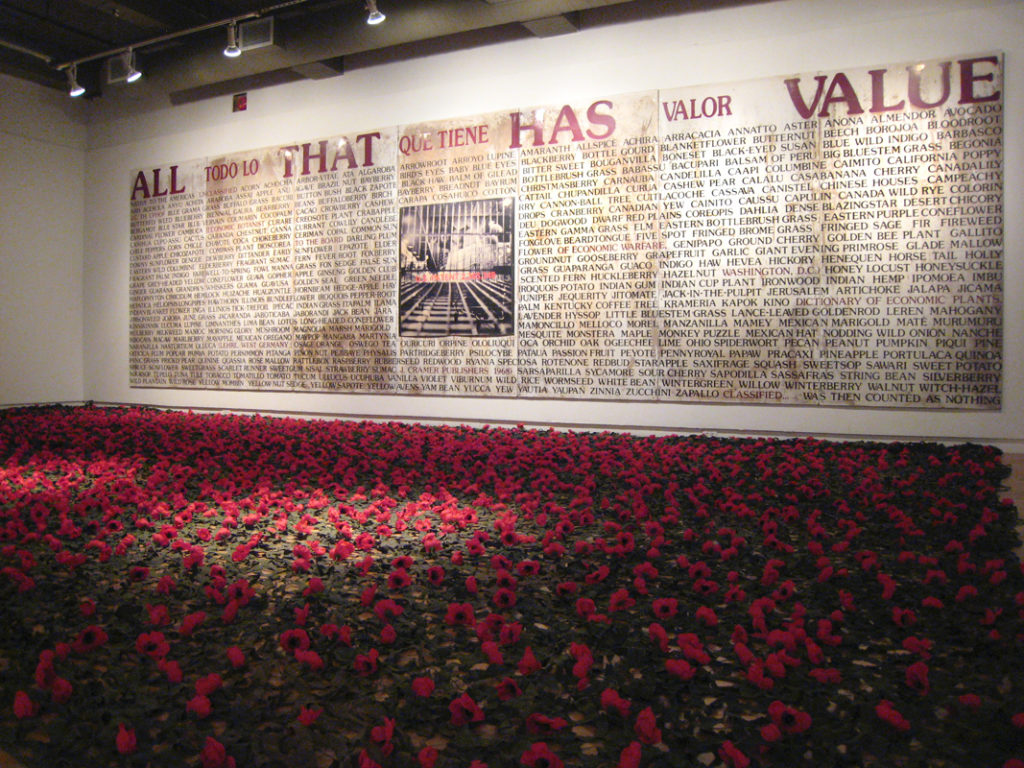Ron Benner and Jamelie Hassan’s “The World is a Garden Whose Walls are the State”at A Space is an exercise in alternate ecologies. The show brings together a selection of works by the two London, Ontario–based artists which invite the outside world into the gallery.
Building on a 2012 exhibition at the Biblioteca Andrés Henestrosa in Oaxaca, Mexico, in which the two artists collaborated, “The World is a Garden Whose Walls are the State” chronicles two individual practices which come together at critical points. At A Space, the depth of these complementary practices expresses itself through works brought into the warm and enclosed space of the gallery from previous site-specific and outdoor installations; some new works made for the show also complement this array.
Particularly poignant is the pairing of a billboard work of Benner’s with a large camouflage-net work of Hassan’s which loosely carpets the floor below.
Ron Benner’s All That Has Value (1993–2014) has as imposing presence—it has previously been installed at Toronto’s Harbourfront Centre and at London’s Grosvenor Lodge, where context demanded an impressive scale. The weathered installation is incantatory: it lists a series of plant names, split by insertions of bureaucratic text. At the centre of the billboard, an indistinct image features prison-like bars and a patent number. The title text at the top of the billboard, “ALL THAT HAS VALUE/TODO LO QUE TIENE VALOR” presides over the list, signifying its elements as consumable and marketable. Like a field guide or encyclopedia devoid of contextual information, Benner’s billboard highlights the violences of imposing “use value” upon plants, and of the colonial act of re-inscribing use upon flora indigenous to the Americas.
Benner’s list gestures to the diverging critical contexts of plant life—the histories and memories that operate beyond mere commercial usefulness. Installed in the gallery above Hassan’s Poppy Cover (for Holy Roller) (2010), the work draws out questions regarding the cultural specificity of plants and their uses.
Although Hassan’s green net with attached silk poppies was originally conceived as a cover for a Second World War tank that has stood in a monument in London’s Victoria Park since the 1950s, the form of Hassan’s sewn-on poppies sidesteps the immediate association with plastic Remembrance Day poppies. Here, poppies (which threaten to read as sometimes-sentimental symbols of peace and harmony in a Canadian context) awaken their myriad uses and symbolisms beyond this culturally dominant reading, including the production of opiates, perfumes, paints and foodstuffs.
Installed together, Benner’s billboard and Hassan’s net meet, conceptually, at the intersection of plants and politics—they unearth the human machinations that underlie every garden.
A related panel will take place at A Space on December 5 from 5 to 7 p.m. with artists Ron Benner and Jamelie Hassan, as well as essayists Julian Jason Haladyn and Christopher Régimbal.









